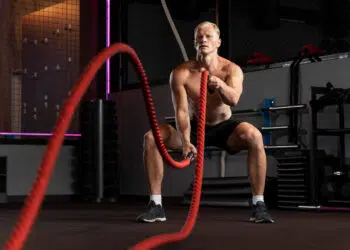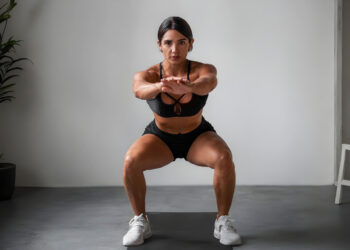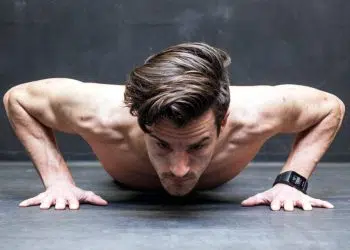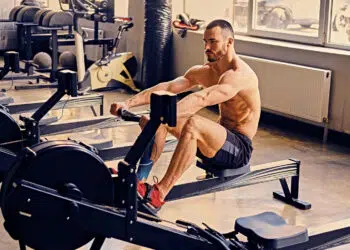A variation of the classic jumping jack, low jacks are a bodyweight-only cardio-based exercise that burns fat, boosts your cardiovascular fitness, and strengthens your core and leg muscles. It’s also simple to perform, relatively low impact, and a very convenient option that requires little space.
Check out our full guide below to learn about proper movement execution, benefits, variations, muscles worked and more.
How To Do Low Jacks
While low jacks are a simple exercise, it’s important to understand proper body positioning, technique and movement execution. Below we’ve included step-by-step instructions on how to perform low jacks safely and effectively.
- Stand with your feet placed just outside of shoulder width, then bend your knees and squat down until your upper legs are slightly above parallel to the floor. Relax your arms by your sides.
- Tense your core muscles, jump your feet together while keeping your knees bent and then jump your feet back out to the starting position while either extending your arms overhead simultaneously or interlocking your hands and holding them in front of you.
- Repeat for the desired duration or number of repetitions.
Check out the video tutorial below.
Low Jacks Exercise Tips
Here we’ve included a few tips to ensure you prevent injuries and get the most out of this exercise.
- Avoid jumping your feet out too far apart beyond slightly outside of shoulder width. This is not only dangerous for your knees and ankles but it does not make the exercise any more effective.
- Remember to keep your knees bent throughout the entire duration of the exercise. This activates more of the lower body and core muscles which is one of the main advantages over conventional jumping jacks.
- Beginners should start slow and perform low jacks at a slow pace, ensuring proper form before increasing the intensity.
- Perform low jacks at a faster pace to speed up the intensity.
- Perform low jacks on a softer surface such as an exercise mat to reduce the impact on your joints.
Low Jacks Benefits
Why should you include low jacks in your fitness regime? Let’s talk about the benefits of this equipment-free activity.
Burn calories, lose body fat
Jumping jacks have a high MET (metabolic equivalent of task) which means they burn a pretty decent amount of calories when performed with moderate to high intensity.
Level Up Your Fitness: Join our 💪 strong community in Fitness Volt Newsletter. Get daily inspiration, expert-backed workouts, nutrition tips, the latest in strength sports, and the support you need to reach your goals. Subscribe for free!
Although low jacks can be performed at any pace which makes them a great option for different fitness levels. Therefore, you can slow them down or speed up the tempo to burn more calories which could result in increased fat loss. But remember that your overall nutrition and exercise habits will ultimately determine your weight loss success.
Learn more about MET value and get an estimate of how many calories you’ll burn during jumping jacks based on weight and intensity.
Improve your overall health
Exercise helps to stave off chronic diseases, it helps with weight management and has benefits for mental health and well-being. Not to mention, with rapid advancements in technology, and more people sitting down to work for 8+ hours per day, people are becoming more and more sedentary which is not good.
According to a post by the Centers for Disease Control and Prevention, engaging in at least 150 minutes of physical activity per week lowers the risk for heart disease and stroke, two leading causes of death in the United States (1).
To take it a step further, the same publication found that 110,000 deaths in US adults ages 40 and older could be prevented with just ten additional minutes of moderate to intense exercise per day (1).
Convenient cardio workout
Because low jacks can be done from almost anywhere, there’s no excuse to not maintain your fitness whether you’re trapped indoors or on the go. Play your favorite tunes or set up in front of the flat screen and you have a great cardio activity that comes with tons of benefits.
No equipment needed
Bodyweight exercises have pros and cons but if you’re a beginner to fitness, or need a quick and easy way to get your heart racing (which has many benefits on its own) with no setup or equipment required, then low jacks are the perfect solution.
Relatively low impact
Low jacks are not a no-impact exercise as they do involve jumping your feet out and together. However, compared to jogging, running, and other forms of activity, they are still easier on the joints when done with good technique. These types of exercises are better for individuals who are a little overweight. However, it may not be the best option for those with limited mobility and flexibility.
Level Up Your Fitness: Join our 💪 strong community in Fitness Volt Newsletter. Get daily inspiration, expert-backed workouts, nutrition tips, the latest in strength sports, and the support you need to reach your goals. Subscribe for free!
3 Low Jacks Variations
While low jacks are an effective equipment-free bodyweight cardio option, these variations offer some variety and possible advantages.
1. Jumping jacks
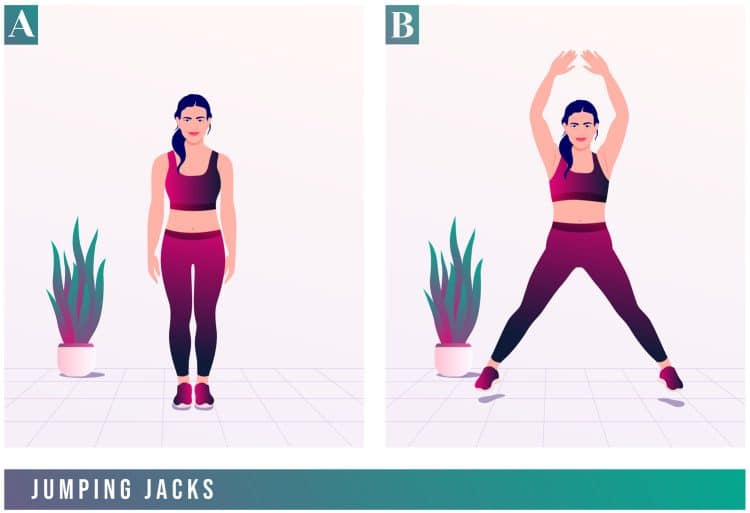
The legendary jumping jack has stood the test of time from its use as part of military fitness assessments to physical fitness education programs and everyday exercise routines.
Jumping jacks offer many of the same benefits as low jacks, although the former may not be as beneficial for the lower body and core muscles. But they’re also not quite as challenging, focusing more on the cardio aspect rather than including the resistance portion that makes low jacks seemingly more challenging.
2. Cross jacks
A unique variation that takes the jumping jack and adds a twist (or a cross), cross jacks are performed as the name suggests, by alternating crossing your limbs – both the legs and arms.
We’ve included a video example below.
3. Jack press
A great way to add resistance to your jumping jack training therefore increasing the intensity is to add a weighted overhead press using either a medicine ball or similar weighted object of your choice. The jack press combines the jumping jack and press, providing resistance for both the lower and upper body unlike the bodyweight-alone variations.
To do it, start with your feet together and hold the weight in both hands in front of your chest. Jump your feet out just slightly wider than shoulder width while pressing the object overhead at the same time. Then jump your feet back together and bring the weight back down to the starting position.
Muscles Worked
While not your typical muscle-building focused exercise, low jacks involve several muscle groups which are primarily those that make up the lower body and core.
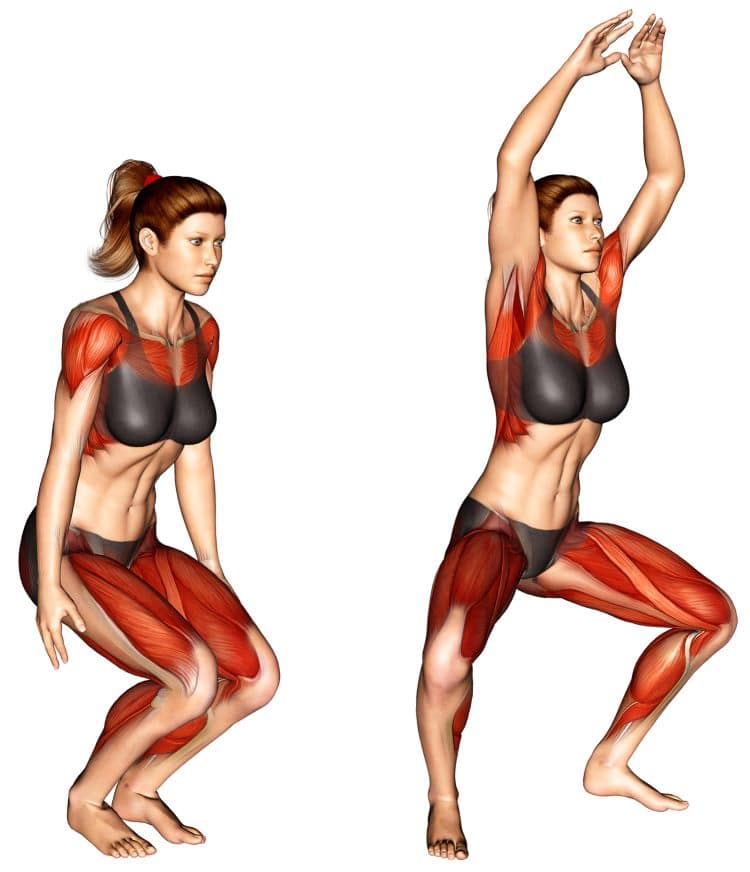
Lower body
Low jacks activate everything from the hip flexors to the glutes, quadriceps, hamstrings, calves and muscles of the feet that allow us to squat, jump, run, and perform pretty much all athletic activities. While you probably won’t build massive quads from including them in your workouts, low jacks can help to keep your leg and hip muscles strong, flexible and mobile alongside a healthy fitness routine.
Core
Total body activities involve more of the core muscles than many realize. They play such an important role in stabilizing and maintaining a strong spine, upright posture and mobility of the trunk.
Sets and Reps
Is there a perfect or ideal set and rep range for low jacks? Short answer, no. As with any form of exercise, how much you can and should do depends on your level of training experience and your goals too.
For example, if you’re just starting out, it may be best to do two to three sets of 15-25 low jacks and gradually increase the workload. More experienced exercisers or athletes can increase their sets and reps for improved cardio conditioning.
Jack Up Your Workout Intensity
Jumping jack variations are here to stay and low jacks definitely have their place in a bodyweight calisthenics workout routine. While the conventional jumping jack offers an easy cardio option, this half squat version has similar benefits plus a resistance training component to it.
Interested in measuring your progress? Check out our strength standards for Half Squat, Jumping Jack, Squat.


